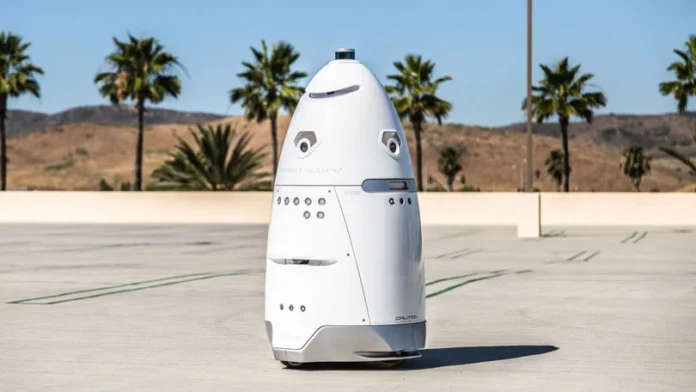In a recent incident outside the headquarters of Knightscope—a robotics startup in Silicon Valley—a middle-aged man allegedly knocked over one of the company’s five-foot-tall, 300-pound security robots during its regular patrol. This incident occurred around 8 p.m. as the K5 model, designed to continuously monitor the parking area, was doing its routine rounds. Following the impact, the machine, which resembles a futuristic blend between R2-D2 and a Dalek from “Doctor Who,” activated its alarm system and notified nearby staff.
Knightscope employees promptly detained the individual, and law enforcement later arrested him on charges related to prowling and public intoxication; police noted that he smelled strongly of alcohol. Despite this disruption, the K5 returned to its duties without issue.
Bill Santana Li, CEO of Knightscope, emphasizes the takeaway from the event, advising, “Don’t mess with a K5.” Since its establishment in 2013, Knightscope has been producing autonomous robots that patrol various venues including shopping malls, sports arenas, and corporate campuses of companies such as Microsoft, Uber, and Juniper Networks. These robots are available for rent at $7 per hour, offering a cost-effective alternative to hiring human security personnel.
Though the robots are not designed to physically confront individuals, they are equipped with tools like lasers, thermal cameras, and GPS. They are capable of detecting a range of sounds—from car horns to breaking glass and distressed shouts—and can scan up to 300 license plates per minute. When any unusual activity is detected, the K5 alerts human security or local law enforcement.
Li explains that the primary goal is to augment the capabilities of human security teams, effectively giving them “superhuman” sensory abilities rather than replacing them entirely.
While these 300-pound machines are non-weaponized, they have previously caused unintentional harm. In 2016, a K5 robot was reported to have run over a toddler’s foot outside a Palo Alto mall, resulting in a swollen foot and a minor scrape, which sparked public debate over the role of robotics in security.
Another notable episode occurred in April, when a K5 encountered a disruptive individual outside Knightscope’s own offices. According to Stacy Dean Stephens, the company’s vice president of marketing and sales, the robot performed as intended by recognizing the abnormal situation, sounding an alarm, and reporting the incident. Stephens remarked that this event underscores Knightscope’s mission of uniting human effort with robotic technology to combat crime.
Currently, Knightscope serves 19 clients across five U.S. states, with most of its deployments focused on patrolling parking lots and office complexes. The effectiveness of these robots has varied: recent reports include assisting law enforcement in tracking down a vandalism suspect and alerting authorities when someone misuses a parking space designated for expectant mothers.
Li suggests that the presence of such a conspicuous security asset might deter criminal behavior, drawing a parallel to how a marked law enforcement vehicle can alter potential offenders’ actions.
Unlike human security guards, who must often pass background checks and complete several hours of training (and, in places like California, obtain a license), these robots operate based on programmed data. They make decisions from environmental inputs without any personal bias, never call in sick, and lack any emotional disposition—though they do carry the risk of malfunction if hacked or misdirected.





